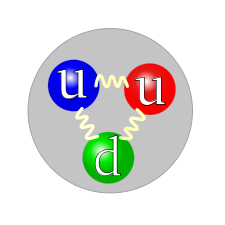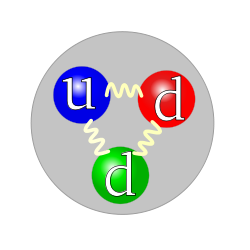At this point I think we should go on to explaining the Standard model of particle physics, because I disagree with almost everything it attempts to explain, my theory will not make any sense at all unless it also explains everything which has so far been discovered.
There are however, many problems with the Standard Model as the scientists working on it would admit.
Hadrons is the name given to the group covering protons and nuetrons.
Quantum chromodynamics (QCD)
In theoretical physics, quantum chromodynamics (QCD) is a theory of the strong interaction (color force), a fundamental force describing the interactions between quarks and gluons which make up hadrons (such as the proton, neutron or pion). It is the study of the SU(3) Yang–Mills theory of color-charged fermions (the quarks). QCD is a quantum field theory of a special kind called a non-abelian gauge theory, consisting of a 'color field' mediated by a set of exchange particles (the gluons). The theory is an important part of the Standard Model of particle physics. A huge body of experimental evidence for QCD has been gathered over the years
QCD enjoys two peculiar properties:
- Confinement, which means that the force between quarks does not diminish as they are separated. Because of this, it would take an infinite amount of energy to separate two quarks; they are forever bound into hadrons such as the proton and the neutron. Although analytically unproven, confinement is widely believed to be true because it explains the consistent failure of free quark searches, and it is easy to demonstrate in lattice QCD.
- Asymptotic freedom, which means that in very high-energy reactions, quarks and gluons interact very weakly. This prediction of QCD was first discovered in the early 1970s by David Politzer and by Frank Wilczek and David Gross. For this work they were awarded the 2004 Nobel Prize in Physics.
There is no known phase-transition line separating these two properties; confinement is dominant in low-energy scales but, as energy increases, asymptotic freedom becomes dominant.
Confinement
Color confinement, often simply called confinement, is the physics phenomenon that color charged particles (such as quarks) cannot be isolated singularly, and therefore cannot be directly observed.[1] Quarks, by default, clump together to form groups, or hadrons. The two types of hadrons are the mesons (one quark, one antiquark) and the baryons (three quarks). The constituent quarks in a group cannot be separated from their parent hadron, and this is why quarks can never be studied or observed in any more direct way than at a hadron level.[2]
Kaon (K-meson)
In particle physics, a kaon (![]() /ˈkeɪ.ɒn/, also called a K-meson and denoted K[nb 1]) is any one of a group of four mesons distinguished by the fact that they carry a quantum number called strangeness. In the quark model they are understood to contain a strange quark (or antiquark), paired with an up or down antiquark (or quark).
/ˈkeɪ.ɒn/, also called a K-meson and denoted K[nb 1]) is any one of a group of four mesons distinguished by the fact that they carry a quantum number called strangeness. In the quark model they are understood to contain a strange quark (or antiquark), paired with an up or down antiquark (or quark).
Kaons have proved to be a copious source of information on the nature of fundamental interactions since their discovery in 1947. They were essential in establishing the foundations of the Standard Model of particle physics, such as the quark model of hadrons and the theory of quark mixing (the latter was acknowledged by a Nobel Prize in Physics in 2008). Kaons played a distinguished role in our understanding of fundamental conservation laws: the discovery of CP violation (a phenomenon generating the observed matter-antimatter asymmetry of the universe), which was acknowledged by a Nobel prize in 1980, was made in the kaon system.
The Standard Model of particle physics is a theory concerning the electromagnetic, weak, and strong nuclear interactions, which mediate the dynamics of the known subatomic particles. Developed throughout the mid to late 20th century, the current formulation was finalized in the mid 1970s upon experimental confirmation of the existence of quarks. Since then, discoveries of the bottom quark (1977), the top quark (1995) and the tau neutrino (2000) have given further credence to the Standard Model. Because of its success in explaining a wide variety of experimental results, the Standard Model is sometimes regarded as a theory of almost everything.
Still, the Standard Model falls short of being a complete theory of fundamental interactions because it does not incorporate the physics of dark energy nor of the full theory of gravitation as described by general relativity. The theory does not contain any viable dark matter particle that possesses all of the required properties deduced from observational cosmology. It also does not correctly account for neutrino oscillations (and their non-zero masses). Although the Standard Model is theoretically self-consistent, it has several apparently unnatural properties giving rise to puzzles like the strong CP problem and the hierarchy problem.

| Mesons of spin 0 form a nonet | |
| Composition | Composite—Quarks and antiquarks |
|---|---|
| Statistics | Bosonic |
In particle physics, a nonet is a set of particles transforming as a nine dimensional representation of some symmetry group, one such occurs in mesons.
Until recently, it was believed that some experiments showed the existence of pentaquarks — "exotic" baryons made of four quarks and one antiquark.[1][2] The particle physics community as a whole did not view their existence as likely in 2006,[3] and in 2008, considered evidence to be overwhelmingly against the existence of the reported pentaquarks.[4]
A pentaquark is a hypothetical subatomic particle consisting of four quarks and one antiquark bound together (compared to three quarks in normal baryons). As quarks have a baryon number of +1⁄3, and antiquarks of −1⁄3, it would have a total baryon number of 1, thus being classified as an exotic baryon. The existence of pentaquarks was originally hypothesized by Michał Praszałowicz in 1987.[1]
Several experiments reported the existence of pentaquark states in the mid 2000s, but later experiments and re-analysis of the data showed them to be statistical effects rather than true resonances.
Resonance
In particle physics, a resonance is the peak located around a certain energy found in differential cross sections of scattering experiments. These peaks are associated with subatomic particles (such as nucleons, delta baryons, upsilon mesons) and their excitations. The width of the resonance (Γ) is related to the lifetime (τ) of the particle (or its excited state) by the relation
where ħ is the planck constant.
Quantum numbers describe values of conserved quantities in the dynamics of the quantum system. Perhaps the most peculiar aspect of quantum mechanics is the quantization of observable quantities. This is distinguished from classical mechanics where the values can range continuously. Quantum numbers often describe specifically the energies of electrons in atoms, but other possibilities include angular momentum, spin etc. Any quantum system can have one or more quantum numbers; it is thus rigorous to list all possible quantum numbers.
Hadrons
In particle physics, a hadron ![]() i/ˈhædrɒn/ (Greek: ἁδρός, hadrós, "stout, thick") is a composite particle made of quarks held together by the strong force (as atoms and molecules are held together by the electromagnetic force). Hadrons are categorized into two families: baryons (made of three quarks) and mesons (made of one quark and one antiquark).
i/ˈhædrɒn/ (Greek: ἁδρός, hadrós, "stout, thick") is a composite particle made of quarks held together by the strong force (as atoms and molecules are held together by the electromagnetic force). Hadrons are categorized into two families: baryons (made of three quarks) and mesons (made of one quark and one antiquark).
Other types of hadron may exist, such as tetraquarks (or, more generally, exotic mesons) and pentaquarks (exotic baryons), but no current evidence conclusively suggests their existence. [1][2]

A proton, composed of two up quarks and one down quark. (The color assignment of individual quarks is not important, only that all three colors are present.)
Mesons
In particle physics, mesons (![]() /ˈmiːzɒnz/ or /ˈmɛzɒnz/) are subatomic particles composed of one quark and one antiquark, bound together by the strong interaction. Because mesons are composed of sub-particles, they have a physical size, with a radius roughly one femtometer: 10−15 m, which is about 2⁄3 the size of a proton or neutron. All mesons are unstable, with the longest-lived lasting for only a few 100-millionths (10−8) of a second. Charged mesons decay (sometimes through intermediate particles) to form electrons and neutrinos. Uncharged mesons may decay to photons.
/ˈmiːzɒnz/ or /ˈmɛzɒnz/) are subatomic particles composed of one quark and one antiquark, bound together by the strong interaction. Because mesons are composed of sub-particles, they have a physical size, with a radius roughly one femtometer: 10−15 m, which is about 2⁄3 the size of a proton or neutron. All mesons are unstable, with the longest-lived lasting for only a few 100-millionths (10−8) of a second. Charged mesons decay (sometimes through intermediate particles) to form electrons and neutrinos. Uncharged mesons may decay to photons.
Mesons are not produced by radioactive decay, but appear in nature only as short-lived products of very high-energy interactions in matter, between particles made of quarks. In cosmic ray interactions, for example, such particles are ordinary protons and neutrons. Mesons are also frequently produced artificially in high-energy particle accelerators that collide protons, anti-protons, or other particles containing quarks.
Baryon
A baryon is a composite particle made up of three quarks (as distinct from mesons, which comprise one quark and one antiquark). Baryons and mesons belong to the hadron family, which are the quark-based particles. The name "baryon" comes from the Greek word for "heavy" (βαρύς, barys), because, at the time of their naming, most known particles had lower masses than the baryons.
As quark-based particles, baryons participate in the strong interaction, whereas leptons, which are not quark-based, do not. The most familiar baryons are the protons and neutrons that make up most of the mass of the visible matter in the universe. Electrons (the other major component of the atom) are leptons. Each baryon has a corresponding antiparticle (antibaryon) where quarks are replaced by their corresponding antiquarks. For example, a proton is made of two up quarks and one down quark; and its corresponding antiparticle, the antiproton, is made of two up antiquarks and one down antiquark.
Tetraquark
In particle physics a tetraquark is a hypothetical meson composed of four valence quarks. In principle, a tetraquark state may be allowed in quantum chromodynamics, the modern theory of strong interactions. However, there has been no confirmed report of a tetraquark state to date. Any established tetraquark state would be an example of an exotic hadron which lies outside the quark model classification.
In 2003 a particle temporarily called X(3872), by the Belle experiment in Japan, was suggested as a tetraquark candidate[1] as it was originally conjectured in.[2] The name X
is a temporary name, indicating that there are still some questions
about its properties to be tested. The number following is the mass of
the particle in MeV. (More)

